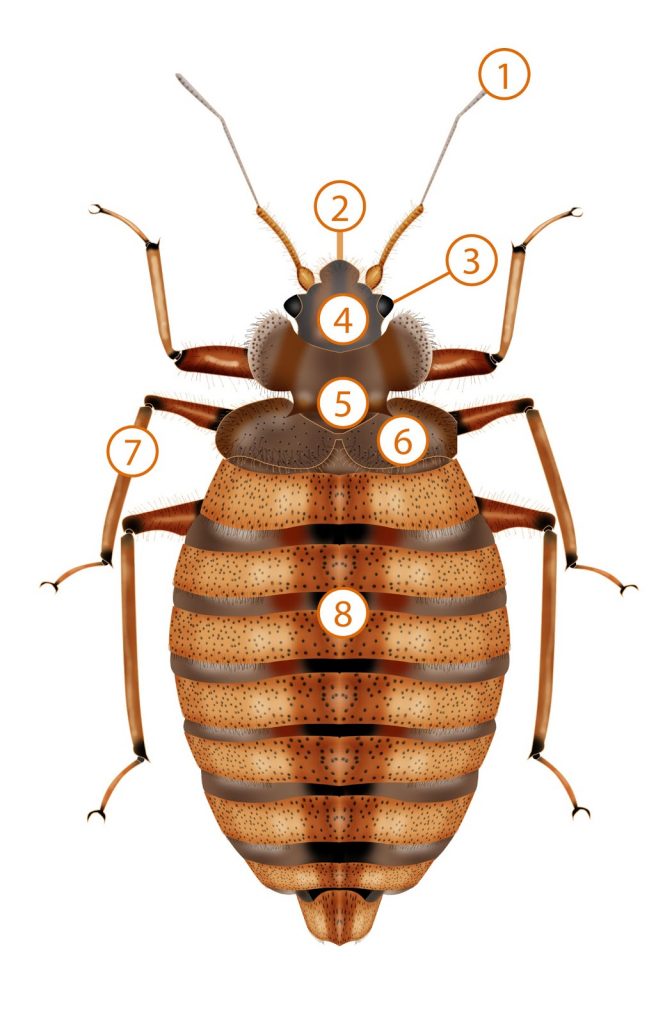For most homeowners, it is hard to tell one flat round brown bug from the next, but once you know what to look for and where, it becomes easier to identify just what bug is invading your home!
What are bed bugs?
Bed bugs are rusty brown and wingless. Because their bodies are flat and low to the ground, they can hide in small cracks, crevices, and folds of cloth. They feed on blood and often feed on sleeping humans. Check for signs of bed bug eggs in the seams of your mattress. In the case of larger bed bug infestations, they may even come out during the day to feed.
How big are bed bugs?
A mature bed bug will be the size and shape of an apple seed, but their hatchlings are only as big as a poppy seed.
A bed bug’s tiny size and ability to hide make it relatively difficult to detect visually. The idea, however, that bed bugs are impossible to see with the naked eye is a myth.
What color are bed bugs?
Bed bugs are a clear/white color when first hatched. Throughout the bed bug life cycle, their coloring will change to a dark reddish brown. Immediately after feeding, a bed bug’s color will redden, and its thorax will also appear swollen.

Anatomy Breakdown
1: Antennae
Bed bugs use antennae as sensors to guide them towards sleeping hosts, where the insect can feed. Each antenna has four segments, approximately half as long as the insect’s body.
2: Proboscis
The proboscis is a small tube bed bugs use to draw blood from their host. When not in use the proboscis hides under their mouth, elongating when it is time to feed. As bed bugs feed, the proboscis injects saliva into their host. This saliva possesses anti-coagulating properties, allowing the pest to drink its fill of blood unnoticed. Each bite from a bed bug draws about 0.0055 milliliters of blood.
3: Eyes
A bed bug’s eyes are comprised of many repeating segments called ommatidia. Compared to a mammal’s eyes, ‘compound eyes’ are highly sensitive to movement. This sensitivity helps bed bugs avoid danger and stay hidden.
4: Head
Bed bugs have heads that are short and broad, which attach to their thorax.
5: Thorax
The thorax is part of the insect where its legs attach to the body. This segment also connects to the head and enables the bed bug to move.
6: Wing Pads
Wing pads indicate where wings would usually develop as an insect matures. While adult bed bugs have wing pads, they are only vestigial wings. Meaning their wings do not fully develop and they never gain the ability to fly. It is believed bed bugs once had wings but over time evolved to no longer require them.
7: How many legs do bed bugs have
Bed bugs have evolved to be expert travelers. Due in part to six legs which are made to crawl. An adult bed bug can cover four feet in one minute. Each leg is tipped with a claw that can be used to grip rough surfaces, climb, and hold onto a host as they feed. These insects lack suction pads making it difficult for them to climb smooth surfaces.
8: Abdomen
There are 11 segments that create the structure of a bed bug’s abdomen. As the pest feeds, these segments will expand, allowing the blood being consumed to be stored. Immediately after a bed bug has fed, the abdomen will appear swollen and reddish in color.
The shape of a bed bug’s abdomen indicates whether the insect is male or female. Male bed bugs have a pointed tip at the rear of their abdomen, and females have a rounded tip.
If you think you have the beginnings of a bed bug infestation or are waking up with bed bug bites, it is important to act fast. Contact the pros at Pronto Pest Management today to schedule an inspection.
